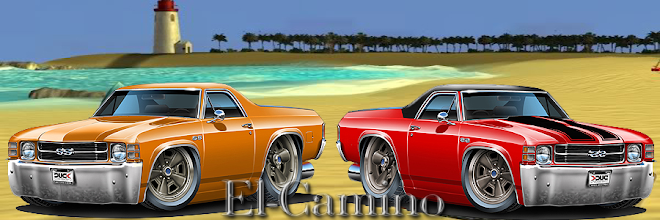1987 CHEVROLET EL CAMINO Recall - POWER TRAIN:AUTOMATIC TRANSMISSION:LEVER AND LINKAGE:COLUMN SHIFT
Problem: MANUAL VALVE LINK IN THE TRANSMISSION MAY HAVE BEEN IMPROPERLY FORMED. Recall Details - 10/26/1987
1984 CHEVROLET EL CAMINO Recall - SEATS:FRONT ASSEMBLY:RECLINER
Problem: SOME VEHICLES HAVE BUCKET SEAT BACK LOCKS THAT DO NOT CONFORM TO FEDERAL MOTOR VEHICLE SAFETY STANDARD 207, ANCHORAGE OF SEATS. IN EVENT OF A CRASH, THE SEAT BACK LOCK MAY NOT FUNCTION. Recall Details - 2/6/1984
1983 CHEVROLET EL CAMINO Recall - SERVICE BRAKES, HYDRAULIC:FOUNDATION COMPONENTS:HOSES, LINES/PIPING, AND FITTINGS
Problem: THE MASTER CYLINDER REAR BRAKE PIPE, WHICH CARRIES BRAKE FLUID TO THE REAR BRAKES, MAY DEVELOP A LEAK DUE TO EXTENDED CHAFING ON THE AIR CLEANER RESONATOR BRACKET. Recall Details - 10/13/1983
1981 CHEVROLET EL CAMINO Recall - SUSPENSION:REAR
Problem: THE BOLTS THAT ATTACH THE LOWER REAR CONTROL ARM TO THE FRAME MAY FRACTURE. THE REAR CONTROL ARM SUPPORTS AND POSITIONS THE REAR AXLE. FRACTURE OF THE BOLTS WOULD ALLOW THE CONTROL ARM TO DROP FREE. Recall Details - 2/25/1981
1981 CHEVROLET EL CAMINO Recall - WHEELS:CENTER SECTION
Problem: "TX" HEAVY DUTY WHEELS MAY HAVE BEEN MANUFACTURED WITH LAMINATED STEEL. THE WHEEL DISC MAY FRACTURE AND THE WHEEL AND TIRE COULD PARTIALLY OR COMPLETELY SEPARATE FROM THE VEHICLE. Recall Details - 3/23/1981
1980 CHEVROLET EL CAMINO Recall - SUSPENSION:REAR
Problem: THE BOLTS THAT ATTACH THE LOWER REAR CONTROL ARM TO THE FRAME MAY FRACTURE. THE REAR CONTROL ARM SUPPORTS AND POSITIONS THE REAR AXLE. FRACTURE OF THE BOLTS WOULD ALLOW THE CONTROL ARM TO DROP FREE. Recall Details - 2/25/1981
1980 CHEVROLET EL CAMINO Recall - POWER TRAIN:AXLE ASSEMBLY:AXLE SHAFT
Problem: REAR AXLE ASSEMBLY MAY HAVE AXLES THAT WERE IMPROPERLY MANUFACTURED. THIS CONDITION MAY RESULT IN SEPARATION OF THE AXLE SHAFT AND WHEEL ASSEMBLY FROM THE VEHICLE. Recall Details - 11/24/1984
1980 CHEVROLET EL CAMINO Recall - SERVICE BRAKES, HYDRAULIC:FOUNDATION COMPONENTS:DRUM:WHEEL CYLINDERS
Problem: EXCESSIVE ENLARGEMENT OF THE WHEEL CYLINDER PILOT HOLE IN THE REAR BRAKE BACKING PLATE COULD ALLOW THE WHEEL CYLINDER TO ROTATE AND CAUSE LOSS OF BRAKE FLUID. CONSEQUENCE OF DEFECT: A LOSS OF BRAKE FLUID LEADS TO LOSS OF REAR BRAKE ACTION, CREATING THE POTENTIAL FOR AN ACCIDENT. FRONT BRAKES WOULD REMAIN OPERATIONAL. Recall Details - 4/29/1985
1979 CHEVROLET EL CAMINO Recall - SERVICE BRAKES, HYDRAULIC:FOUNDATION COMPONENTS:DRUM:WHEEL CYLINDERS
Problem: EXCESSIVE ENLARGEMENT OF THE WHEEL CYLINDER PILOT HOLE IN THE REAR BRAKE BACKING PLATE COULD ALLOW THE WHEEL CYLINDER TO ROTATE AND CAUSE LOSS OF BRAKE FLUID. CONSEQUENCE OF DEFECT: A LOSS OF BRAKE FLUID LEADS TO LOSS OF REAR BRAKE ACTION, CREATING THE POTENTIAL FOR AN ACCIDENT. FRONT BRAKES WOULD REMAIN OPERATIONAL. Recall Details - 4/29/1985
1979 CHEVROLET EL CAMINO Recall - POWER TRAIN:AXLE ASSEMBLY:AXLE SHAFT
Problem: REAR AXLE ASSEMBLY MAY HAVE AXLES THAT WERE IMPROPERLY MANUFACTURED. THIS CONDITION MAY RESULT IN SEPARATION OF THE AXLE SHAFT AND WHEEL ASSEMBLY FROM THE VEHICLE. Recall Details - 11/24/1984
1979 CHEVROLET EL CAMINO Recall - SUSPENSION:REAR
Problem: THE BOLTS THAT ATTACH THE LOWER REAR CONTROL ARM TO THE FRAME MAY FRACTURE. THE REAR CONTROL ARM SUPPORTS AND POSITIONS THE REAR AXLE. FRACTURE OF THE BOLTS WOULD ALLOW THE CONTROL ARM TO DROP FREE. Recall Details - 2/25/1981
1978 CHEVROLET EL CAMINO Recall - ENGINE AND ENGINE COOLING:COOLING SYSTEM:FAN
Problem: THE HUB PORTION OF THE FAN BLADE ASSEMBLY COULD CRACK DUE TO HIGH STRESS LEVELS GENERATED DURING ENGINE OPERATING CONDITIONS. EVENTUALLY, THE BLADE COULD BREAK APART AT THE HUB AND BLADE PIECES COULD BE PROPELLED INTO THE ENGINE. IF THE HOOD IS OPEN WHILE THE ENGINE IS RUNNING, THE FRAGMENTS WOULD BE FREE TO FLY FROM THE VEHICLE. Recall Details - 6/13/1978
1978 CHEVROLET EL CAMINO Recall - SUSPENSION:REAR
Problem: THE BOLTS THAT ATTACH THE LOWER REAR CONTROL ARM TO THE FRAME MAY FRACTURE. THE REAR CONTROL ARM SUPPORTS AND POSITIONS THE REAR AXLE. FRACTURE OF THE BOLTS WOULD ALLOW THE CONTROL ARM TO DROP FREE. Recall Details - 2/25/1981
1978 CHEVROLET EL CAMINO Recall - POWER TRAIN:AXLE ASSEMBLY:AXLE SHAFT
Problem: REAR AXLE ASSEMBLY MAY HAVE AXLES THAT WERE IMPROPERLY MANUFACTURED. THIS CONDITION MAY RESULT IN SEPARATION OF THE AXLE SHAFT AND WHEEL ASSEMBLY FROM THE VEHICLE. Recall Details - 11/24/1984
1978 CHEVROLET EL CAMINO Recall - SERVICE BRAKES, HYDRAULIC:FOUNDATION COMPONENTS:DRUM:WHEEL CYLINDERS
Problem: EXCESSIVE ENLARGEMENT OF THE WHEEL CYLINDER PILOT HOLE IN THE REAR BRAKE BACKING PLATE COULD ALLOW THE WHEEL CYLINDER TO ROTATE AND CAUSE LOSS OF BRAKE FLUID. CONSEQUENCE OF DEFECT: A LOSS OF BRAKE FLUID LEADS TO LOSS OF REAR BRAKE ACTION, CREATING THE POTENTIAL FOR AN ACCIDENT. FRONT BRAKES WOULD REMAIN OPERATIONAL. Recall Details - 4/29/1985
